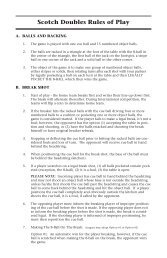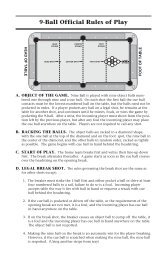8 Ball Rules - VNEA
8 Ball Rules - VNEA
8 Ball Rules - VNEA
You also want an ePaper? Increase the reach of your titles
YUMPU automatically turns print PDFs into web optimized ePapers that Google loves.
<strong>VNEA</strong> <strong>Rules</strong> and Scoring<br />
headstring, unless he/she first shoots the cue ball past the headstring and<br />
causes the cue ball to come back behind the headstring and hit the object<br />
ball. If a player positions the cue ball completely and obviously outside the<br />
kitchen and shoots the cue ball, it is a foul, if called by the opponent.<br />
6. The opposing player must inform the breaking player of improper position<br />
ing of the cue ball before the shot is made. If the opposing player does not<br />
so inform the breaking player before the shot is made, the break is considered<br />
legal. If the shooting player is informed of improper positioning,<br />
he/she must then reposition the cue ball.<br />
7. Making The 8-<strong>Ball</strong> On The Break: (Leagues may adopt Option #1 or Option #2)<br />
Option #1. An automatic win for the player breaking, however, if the cue<br />
ball is scratched when making the 8-ball on the break, the opponent wins<br />
the game.<br />
Option #2. The breaker may ask for a rerack or have the 8-ball spotted and<br />
continue shooting. Should the breaker pocket the 8-ball and scratch, the<br />
incoming player has the option of spotting the 8-ball and shooting from<br />
behind the headstring or reracking and assuming the break. Using Option<br />
#2, a game cannot be won or lost with an 8-ball on the break, regardless of<br />
what is pocketed on the same shot.<br />
During International Championships and Junior Championships, Option #2<br />
will be used.<br />
8. If the player legally breaks the racked balls and does not make any balls,<br />
his opponent then shoots, having an open table.<br />
9. If a player jumps an object ball off the table on the break shot, it is a foul<br />
and the incoming player has the option of (1) accepting the table in position<br />
and shooting, or (2) taking cue ball in hand behind the headstring and<br />
shooting. Any jumped balls are spotted in numerical order.<br />
C. OPEN TABLE<br />
The table is “open” when the choice of groups (stripes or solids) has not yet been<br />
determined. When the table is open, it is legal to hit a solid first to make a stripe or<br />
vice versa. Note: The table is always open immediately after the break shot. When<br />
the table is open it is legal to hit any solid or stripe or the 8-ball first in the process of<br />
pocketing the called stripe or solid. On an open table, all pocketed balls remain pocketed.<br />
The choice of stripes or solids is not determined on the break even if balls are<br />
made from only one or both groups. THE TABLE IS ALWAYS OPEN IMMEDIATELY<br />
AFTER THE BREAK SHOT. The choice of group is determined only when a player<br />
legally pockets a called object ball after the break shot.<br />
D. GAME<br />
In Call Pocket, obvious balls and pockets do not have to be indicated. It is the opponent’s<br />
right to ask which ball and pocket if he is unsure of the shot. Banks and combinations<br />
are not considered obvious and both the object ball and the pocket must be<br />
called or it is a loss of turn. When calling the shot, it is NEVER necessary to indicate<br />
details such as the number of cushions, banks, kisses, caroms, etc. Any balls pocketed on a<br />
foul remain pocketed, regardless of whether they belong to the shooter or the opponent.<br />
The opening break is not a “called pocket.” Any player performing a break shot in 8-<br />
<strong>Ball</strong> may continue to shoot his next shot so long as he has legally pocketed any object<br />
ball on the break.






